
Daniel Chester French was an American sculptor of the late nineteenth and early twentieth centuries. He is best known for his 1874 sculpture The Minute Man in Concord, Massachusetts, and his 1920 monumental statue of Abraham Lincoln in the Lincoln Memorial in Washington, D.C.
The Albert Einstein Memorial is a monumental bronze statue by sculptor Robert Berks, depicting Albert Einstein seated with manuscript papers in hand. It is located in central Washington, D.C., United States, in a grove of trees at the southwest corner of the grounds of the National Academy of Sciences at 2101 Constitution Avenue N.W., near the Vietnam Veterans Memorial. Two replicas exist at the Israel Academy of Sciences and Humanities and the Georgia Institute of Technology.

There are many outdoor sculptures in Washington, D.C. In addition to the capital's most famous monuments and memorials, many figures recognized as national heroes have been posthumously awarded with his or her own statue in a park or public square. Some figures appear on several statues: Abraham Lincoln, for example, has at least three likenesses, including those at the Lincoln Memorial, in Lincoln Park, and the old Superior Court of the District of Columbia. A number of international figures, such as Mohandas Gandhi, have also been immortalized with statues. The Statue of Freedom is a 19½-foot tall allegorical statue that rests atop the United States Capitol dome.

Randolph Rogers was an American Neoclassical sculptor. An expatriate who lived most of his life in Italy, his works ranged from popular subjects to major commissions, including the Columbus Doors at the U.S. Capitol and American Civil War monuments.

The United States Capitol Complex is a group of twenty buildings and facilities in Washington, D.C., that are used by the federal government of the United States. The buildings and grounds within the complex are managed and supervised by the architect of the Capitol.

The Thomas Jefferson Building is the oldest of the United States Library of Congress buildings. Built between 1890 and 1897, it was originally known as the Library of Congress Building, and subsequently Main Library. Since 1980, it has been named for Thomas Jefferson, a Founding Father and the third U.S. president, whose own book collection formed a core part of the library's collection in 1815. The building is located on First Street, S.E. between Independence Avenue and East Capitol Street in Washington, D.C. across from the U.S. Capitol. The library's John Adams Building is adjacent to it across 2nd Street, and the James Madison Memorial Building faces it across Independence Avenue.

The Thurgood Marshall Federal Judiciary Building (TMFJB) at the crossroads of the Capitol Hill and NoMA neighborhoods in Washington, D.C., houses offices that support the work of the United States Courts, including the Administrative Office of the United States Courts, the Federal Judicial Center, the United States Sentencing Commission, and the Office of the Clerk of the Judicial Panel on Multidistrict Litigation.

The United States Capitol rotunda is the tall central rotunda of the United States Capitol in Washington, D.C. It has been described as the Capitol's "symbolic and physical heart". Built between 1818 and 1824, the rotunda is located below the Capitol dome, which was built between 1857 and 1866.
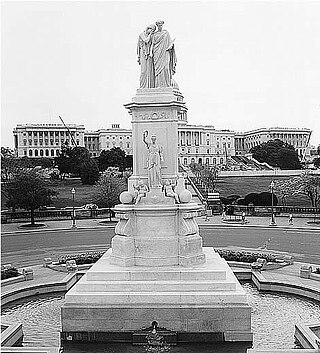
Peace Circle is a traffic circle in Washington, D.C., located at the intersection of Pennsylvania Avenue and First Street NW. At its center is the Peace Monument, also known as the Naval Memorial. It is a monument to the naval deaths during the American Civil War. The monument is topped by the allegorical sculptures of Grief and History. On the southeast side facing the United States Capitol there is a figure of Peace, and on the northwest side, there are figures of Victory and the babies Mars and Neptune. The monument is located on Capitol grounds adjacent to the Capitol Reflection Pool. The monument was sculpted by Franklin Simmons and completed in 1878. The monument was restored in the 1990s.
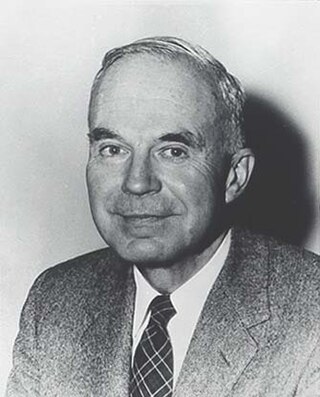
Walker Kirtland Hancock was an American sculptor and teacher. He created notable monumental sculptures, including the Pennsylvania Railroad World War II Memorial (1950–52) at 30th Street Station in Philadelphia, and the World War I Soldiers' Memorial (1936–38) in St. Louis, Missouri. He made major additions to the National Cathedral in Washington, D.C., including Christ in Majesty (1972), the bas relief over the High Altar. Works by him are presently housed at the U.S. Military Academy at West Point, the Library of Congress, the U.S. Supreme Court, and the United States Capitol.

Franklin Bachelder Simmons was a prominent American sculptor of the nineteenth century. Three of his statues are in the National Statuary Hall Collection, three of his busts are in the United States Senate Vice Presidential Bust Collection, and his statue of Ulysses S. Grant is in the United States Capitol Rotunda.
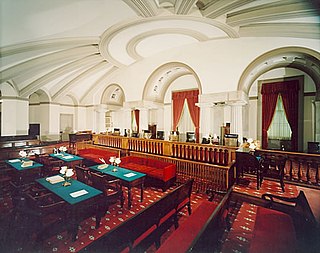
The Old Supreme Court Chamber is the room on the ground floor of the North Wing of the United States Capitol. From 1800 to 1806, the room was the lower half of the first United States Senate chamber, and from 1810 to 1860, the courtroom for the Supreme Court of the United States.
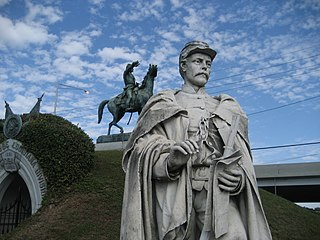
Alexander Doyle (1857–1922) was an American sculptor.
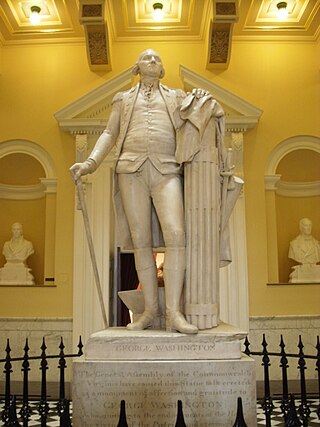
George Washington is a statue by the French sculptor Jean-Antoine Houdon from the late 18th century. Based on a life mask and other measurements of George Washington taken by Houdon, it is considered one of the most accurate depictions of the subject. The original sculpture is located in the rotunda of the Virginia State Capitol in Richmond, Virginia, and it has been copied extensively, with one copy standing in the United States Capitol Rotunda.

The Revolutionary War Door is an artwork by American sculptor Thomas Crawford, located on the United States Capitol House of Representatives wing east front in Washington, D.C., United States. This sculptured door was surveyed in 1993 as part of the Smithsonian's Save Outdoor Sculpture! program.

The statue of John Aaron Rawlins, a United States Army general who served during the Civil War and later as Secretary of War, is a focal point of Rawlins Park, a small public park in Washington, D.C.'s Foggy Bottom neighborhood. It was installed in 1874, but relocated several times between 1880 and 1931. The statue was sculpted by French-American artist Joseph A. Bailly, whose best known work is the statue of George Washington in front of Independence Hall in Philadelphia.

Olive Risley Seward is a lead on burlap statue by American sculptor John Cavanaugh, located at North Carolina Avenue and Sixth Street, Southeast, Washington, D.C., in the Capitol Hill neighborhood.

One Judiciary Square is a highrise office building at 441 Fourth Street NW in the Judiciary Square neighborhood of Washington, D.C. Designed by architect Vlastimil Koubek, the building is 129.67 feet (39.52 m) tall and has approximately 10 floors. Its construction ended in 1990.




















